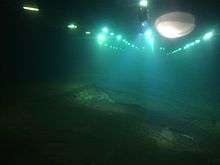Baiheliang Underwater Museum


The Baiheliang Underwater Museum or "White Crane Ridge Underwater Museum"[1]) is an underwater museum built around the White Crane Ridge of Fuling (Chinese: 涪陵白鹤梁), in China. It is China's first underwater museum,[2] and is located in Fuling District,[3] Chongqing Municipality, China.[4]
The museum is located on the Yangtze River in the Three Gorges area, near the Three Gorges Dam. It was opened to the public on 18 May 2009.[4] The construction of the museum began in 2002 and has cost around US$28 million. The main architect was Ge Xiurun of the Institute of Rock and Soil Mechanics and the Chinese Academy of Sciences.[5]
Baiheliang (literally meaning the "White Crane Ridge") is an archaeological site in the north of Fuling District that has been submerged underwater due to the building of the Three Gorges Dam.[5] The museum displays centuries-old inscriptions recording changes in the water level of the Yangtze River for around 1,200 years. The site consists of a stone ridge that is 1,600 meters by 15 meters in size. It is now submerged under 43 meters of water.
Before the Three Gorges Dam was built, the rock ridge was only submerged during summer and autumn. Every 3–5 years, when the water level of the Yangtze dropped during the winter, the ridge and the carvings on it were exposed and visible. The stone fish figures and inscriptions recording water-levels and other information from the Tang Dynasty (618–907 AD) onwards could be viewed by visitors. The carvings include 18 fish carvings, poems written calligraphically, three Bodhisattva carvings, and a crane.
From 1994, China's government departments involved with the protection of Chinese cultural heritage undertook research on the conservation of the stone inscriptions at Baiheliang. After a number of proposals, it was decided to make the site into an underwater museum.
The stone ridge has now been enclosed in an arch-shaped glass covering, filled with purified water. This ensures that the pressure on both sides of the arch is the same. Two underwater channels with long escalators have been installed from the riverbank, allowing museum visitors to descend and view the stone carvings and inscriptions.
Some carvings from White Crane Ridge are also on display in the Three Gorges Museum in the city centre of Chongqing.[6] The museum has been temporarily closed for renovation.[7]
See also
- Baiheliang rock ledge
References
- ↑ "White Crane Ridge Underwater Museum". www.meiyatravel.com. Meiya Travel. Archived from the original on 22 December 2015. Retrieved 24 September 2014.
- ↑ "Under-Water Museum of White Crane Ridge Inscription In Chongqing". www.epeanchina.com. Epean China. Retrieved 24 September 2014.
- ↑ Hessler, Peter (March 2013). "Fuling, China: Return to River Town". National Geographic. Retrieved 24 September 2014.
- 1 2 "Chongqing: The First Underwater Museum in China has Been Built and Opened". www.chinahush.com. Chinahush. 21 May 2009. Retrieved 23 August 2014.
- 1 2 "The Baiheliang Underwater Museum, Fuling, Chongqing Municipality, China". UNESCO. Retrieved 23 August 2014.
- ↑ Zhao Lixia, ed. (29 September 2009). "Three Gorges Museum, Largest Thematic Museum in China". english.cri.cn. China: CRI.cn. Retrieved 24 September 2014.
- ↑ "Underwater museum "White Crane Ridge" temporarily closed". China: CCTV. 25 May 2011. Retrieved 24 September 2014.
External links
-
 Media related to Baiheliang at Wikimedia Commons
Media related to Baiheliang at Wikimedia Commons
Coordinates: 29°42′53″N 107°23′14″E / 29.71477°N 107.38734°E

